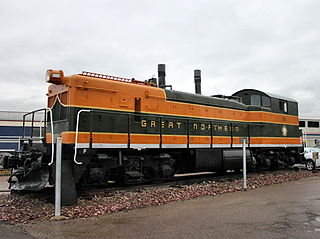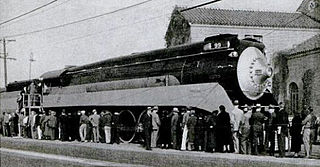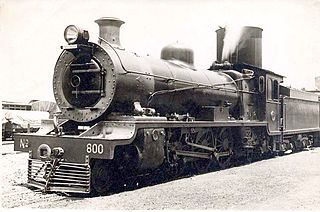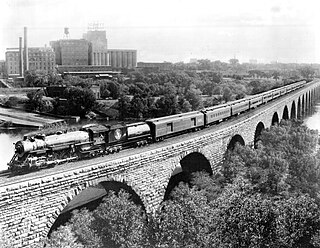
The Great Northern Railway was an American Class I railroad. Running from Saint Paul, Minnesota, to Seattle, Washington, it was the creation of 19th-century railroad entrepreneur James J. Hill and was developed from the Saint Paul & Pacific Railroad. The Great Northern's route was the northernmost transcontinental railroad route in the U.S.

Under the Whyte notation for the classification of steam locomotives, 4-8-4 represents the wheel arrangement of four leading wheels on two axles, eight powered and coupled driving wheels on four axles and four trailing wheels on two axles. The type was first used by the Northern Pacific Railway, and initially named the Northern Pacific, but railfans and railroad employees have shortened the name since its introduction. It is most-commonly known as a Northern.

Under the Whyte notation for the classification of steam locomotives by wheel arrangement, 4-4-2 represents a configuration of a four-wheeled leading bogie, four powered and coupled driving wheels, and two trailing wheels supporting part of the weight of the boiler and firebox. This allows a larger firebox and boiler than the 4-4-0 configuration.

The North Coast Limited was a named passenger train operated by the Northern Pacific Railway between Chicago and Seattle via Bismarck, North Dakota. It started on April 29, 1900, and continued as a Burlington Northern Railroad train after the merger on March 2, 1970 with Great Northern Railway and the Chicago, Burlington and Quincy Railroad. The next year, it ceased operations after the trains which left their originating stations on April 30, 1971, the day before Amtrak began service, arrived at their destinations.

The EMD NW3 was a 1,000 hp (750 kW) road switcher diesel-electric locomotive built by General Motors Electro-Motive Division of La Grange, Illinois between November 1939 and March 1942. A total of seven were built for the Great Northern Railway, the sole original purchaser; they were originally numbered #5400-5406 and later renumbered #175-181.

The GS-2 was a class of streamlined 4-8-4 "Northern" type steam locomotive operated by the Southern Pacific Railroad (SP) from 1937 to 1958. A total of six were built by the Lima Locomotive Works, numbered 4410 through 4415. GS stands for "Golden State" or "General Service."

The NZR AB class was a class of 4-6-2 Pacific tender steam locomotive that operated on New Zealand's national railway system for New Zealand Railways (NZR). Originally an improvement on the 1906 A class, 141 were built between 1915 and 1927 by NZR's Addington Workshops, A & G Price of Thames, New Zealand, and North British Locomotive Company, making the AB class the largest class of steam locomotives ever to run in New Zealand. An additional eleven were rebuilt from the tank version of the AB – the WAB class – between 1947 and 1957. Two North British-made locomotives were lost in the wreck of the SS Wiltshire in May 1922.

Spokane, Portland & Seattle 700 is the oldest and only surviving example of the class "E-1" 4-8-4 "Northern" type steam locomotive and the only surviving "original" Spokane, Portland and Seattle Railway steam locomotive. It was built by the Baldwin Locomotive Works in May 1938. Nearly identical to the class "A-3" Northerns built for Northern Pacific Railway, it burns oil instead of coal.

Havre station is a train station, re-fueling, and service stop for the Amtrak Empire Builder in Havre, Montana. The station, platform, and parking are owned by BNSF Railway, and the station was previously owned and operated by the Great Northern Railway.

Great Northern Railway 1355 is a standard gauge steam railway locomotive built by Baldwin Locomotive Works in 1909 for the Great Northern Railway in the United States. It was built as a 4-6-0, Ten-Wheeler, type, but it had an extensive rebuild in 1924 when it became a 4-6-2, Pacific, type. During its career, it pulled both freight and passenger trains, including the Great Northern's crack Empire Builder and Oriental Limited.
The Michigan train wreck was the worst rail disaster in both North Dakota and Great Northern Railway history. It happened on August 9, 1945, at Michigan, North Dakota, and involved Great Northern's premier train, the Empire Builder.

The South African Railways Class 16 4-6-2 of 1914 was a steam locomotive.

The GCR Class 2 steam locomotive was derived from a Kitson (Leeds) built/Thomas Parker designed prototype 4-4-0 locomotive No. 561, exhibited in Manchester in 1887. The design lead to the production of a series of express steam locomotives built between 1890 and 1894 for use on the Manchester, Sheffield and Lincolnshire Railway, later the Great Central Railway. The last batch of six, built 1894, had larger bearings for the coupled wheels, coil springs for the driving axle and was classified 2A.

The Glacier Park Limited was a named passenger train operated by the Great Northern Railway in the United States that ran between St. Paul and Seattle between 1915 and 1929. The Glacier Park Limited came to be when another one of Great Northern's St. Paul to Seattle routes, The Oregonian was renamed. The Limited also had a split with a small consist going to Portland along the route of the Spokane, Portland and Seattle Railway. The train was meant to promote Great Northern's on-line scenic attraction Glacier Park as a tourist destination, advertising the park's unequaled scenery and easy access by its trains, which stopped on both the Eastern and Western edge of the park.

Great Northern 2584 is a 4-8-4 "Northern" type steam locomotive built by the Baldwin Locomotive Works in Philadelphia, Pennsylvania in March 1930 for the Great Northern Railway (GN) as a member of the S-2 class.

The Great Northern P-2 was a class of 28 4-8-2 "Mountain" type steam locomotives built by the Baldwin Locomotive Works in 1923 and operated by the Great Northern Railway until the late 1950s.
The Great Northern S-1 was a class of 6 4-8-4 Northern type steam locomotives built by the Baldwin Locomotive Works in 1929 and operated by the Great Northern Railway until the late 1950s. They were initially put in passenger service but eventually saw service pulling freight.

Great Northern 2507 is a 4-8-2 "Mountain" type steam locomotive, a member of the P-2 class. Built for passenger service, the locomotive was assigned to pull the Great Northern's mainline passenger trains such as the Empire Builder and Oriental Limited, until being retired in December 1957 and sold to Spokane, Portland and Seattle Railway. GN 2507 is one of only two surviving examples of a P-2 class locomotive and, since 2003, has been on display at Wishram station in Wishram, Washington.

The Great Northern H-5 was a class of 25 4-6-2 "Pacific" type steam locomotives that were originally built as E-14 4-6-0 "Ten Wheelers" by the Baldwin Locomotive Works in 1909 and operated by the Great Northern Railway until the mid-1950s.

Spokane, Portland and Seattle Railway No. 539 is the only preserved example of the class O-3 2-8-2 "Mikado" steam locomotive. It was built by the American Locomotive Company in 1917 for the Northern Pacific Railway as engine No. 1762. It was sold to the Spokane, Portland and Seattle Railway and renumbered 539, in August 1944. It was reconfigured and converted to oil burning in January 1946. The locomotive was retired in 1957, and it was displayed in Esther Short Park, Washington, until 1997. That year, it was moved to Battle Ground for a potential restoration that never came to fruition. In 2007, it was acquired by the Grand Canyon Railway and moved to Williams, Arizona for an operational restoration that also never came to fruition. In 2019, No. 539 was purchased again by the Port of Kalama, who moved it back to Washington and put it on static display inside the Port's Interpretive Center that was constructed in 2014.


















